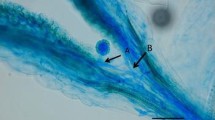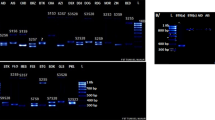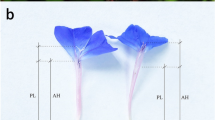Abstract
Pear cultivar ‘Sha 01’ is a sport from ‘Kuerlexiangli’. Field pollination data revealed that ‘Sha 01’ displayed self-compatibility (SC), whereas ‘Kuerlexiangli’ showed self-incompatibility upon self-pollination. Reciprocal pollinations between the two varieties showed that 76% of ‘Kuerlexiangli’ flowers pollinated with ‘Sha 01’ pollen set fruit, but only 7% of ‘Sha 01’ flowers set fruit when pollinated with ‘Kuerlexiangli’ pollen. The pollen performance was monitored with fluorescence microscopy, and it was observed that ‘Sha 01’ accepted self-pollen but rejected ‘Kuerlexiangli’ pollen, whereas ‘Kuerlexiangli’ rejected self-pollen but accepted ‘Sha 01’ pollen. Taken together, ‘Sha 01’ showed SC as a pollen-part mutant. Molecular S-genotyping of ‘Sha 01’, its selfed progeny, and wild-type ‘Kuerlexiangli’ showed that all contained S 22-RNase and S 28-RNase alleles, but showed no nucleotide sequence difference or changes in transcription. After flow cytometry and chromosome number analyses, ‘Sha 01’ was found to be a tetraploid (2n = 68) and ‘Kuerlexiangli’ a diploid (2n = 34). Thus, the S-genotype for ‘Sha 01’ was S 22 S 22 S 28 S 28 and for ‘Kuerlexiangli’ was S 22 S 28 . Ploidy level of ‘Sha 01’ selfed progeny were also determined from leaves using flow cytometry; all seedlings were tetraploids. The S-genotyping for the progeny was identified by S-RNase gene relative optical density for both alleles. Closer inspection of 52 progeny showed that they could be classified into three types S 22 S 22 S 28 S 28 : S 22 S 22 S 22 S 28 : S 22 S 28 S 28 S 28 with the distribution 28:10:14 ≈ 4:1:1; no individual homozygous for either allele was found. Therefore, it could be concluded that only heteroallelic diploid pollen S 22 S 28 could achieve ‘Sha 01’ fertilization through a so-called competitive interaction.






Similar content being viewed by others
References
Anderson MA, Cornish EC, Mau SL, Williams EG, Hoggart R, Atkinson A, Bonig I, Grego B, Simpson R, Roche P, Haley JD, Penschow J, Niall HD, Tregear GW, Coghlan JP, Crawford RJ, Clarke AE (1986) Cloning of cDNA for a stylar glycoprotein associated with expression of self-incompatibility in Nicotiana alata. Nature 321:38–44
Boskovic RI, Wolfram B, Tobutt KR, Cerovic R, Sonneveld T (2006) Inheritance and interactions of incompatibility alleles in the tetraploid sour cherry. Theor Appl Genet 112:315–326
Brewbaker JL (1954) Incompatibility in autotetraploid Trifolium repens 1. Competition and self-compatibility. Genetics 3:307–316
Chawla B, Bernatzky R, Liang W, Marcotrigiano M (1997) Breakdown of self-incompatibility in tetraploid Lycopersicon peruvianum: inheritance and expression of S-related proteins. Theor Appl Genet 95:992–996
Crane MB, Lawrence WJC (1929) Genetical and cytological aspects of incompatibility and sterility in cultivated fruits. J Pomol Hortic Sci 7:276–301
Crane MB, Lawrence WJC (1931) Sterility and incompatibility in diploid and polyploid fruits. J Genet 24:97–107
Crane MB, Lawrence WJC (1938) The genetics of garden plants. Macmillan, London
Crane MB, Lewis D (1942) Genetical studies in pears. III. Incompatibility and sterility. J Genet 43:31–42
Crane MB, Thomas PT (1939) Genetical studies in pear. 1. The origin and behaviour of a new giant form. J Genet 28:287–299
de Nettancourt D (1977) Incompatibility in angiosperms. Springer, Berlin
de Nettancourt D (2001) Incompatibility and incongruity in wild and cultivated plants. Springer, Berlin
de Nettancourt D, Saccardo F, Laneri U, Capaccio E (1974) Self-compatibility in a spontaneous tetraploid of Lycopersicon peruvianum Mill. Polyploidy and induced mutations in plant breeding. IAEA, Vienna, pp 77–84
Dolezel J, Binarova P, Lucretti S (1989) Analysis of nuclear DNA content in plant cells by flow cytometry. Biol Plant 31:113–120
Doyle JI, Doyle JL (1987) A rapid DNA isolation procedure for small quantities of fresh leaf tissue. Phytochem Bull 19:11–15
Golz JF, Su V, Clarke AE, Newbigin E (1999) A molecular description of mutations affecting the pollen component of the Nicotiana alata S locus. Genetics 152:1123–1135
Golz JF, Oh HY, Su V, Kusaba M, Newbigin E (2001) Genetic analysis of Nicotiana pollen-part mutants is consistent with the presence of an S-ribonuclease inhibitor at the S locus. Proc Natl Acad Sci USA 98:15372–15376
Hauck NR, Yamane H, Tao R, Iezzoni AF (2002) Self-compatibility and incompatibility in tetraploid sour cherry (Prunus cerasus L.). Sex Plant Reprod 15:39–46
Hauck NR, Yamane H, Tao R, Iezzoni AF (2006) Accumulation of non-functional S-haplotypes results in the breakdown of gametophytic self-incompatibility in tetraploid Prunus. Genetics 172:1191–1198
Huang SX, Wu HQ, Li YR, Wu J, Zhang SJ, Heng W, Zhang SL (2008) Competitive interaction between two functional S-haplotypes confer self-compatibility on tetraploid Chinese cherry (Prunus pseudocerasus Lindl. CV. Nanjing Chuisi). Plant Cell Rep 27:1075–1085
Ishimizu T, Inoue K, Shinonaka M, Saito T, Terai O, Norioka S (1999) PCR-based method for identifying the S-genotypes of Japanese pear cultivars. Theor Appl Genet 98:961–967
Kao T, McCubbin AG (1996) How flowering plants discriminate between self and non-self pollen to prevent inbreeding. Proc Natl Acad Sci USA 93:12059–12065
Kim HT, Hirata Y, Shin YU, Hwang HS, Hwang JH, Shin IS, Kim DI, Kang SJ, Kim HJ, Shin DY (2004) A molecular technique for selection of self-compatible varieties of Japanese pear (Pyrus pyrifolia Nakai). Euphytica 138:73–80
Lansari A, Iezzoni A (1990) A preliminary analysis of self-incompatibility in sour cherry. Hort Sci 25:636–1638
Lawrence WJC (1930) Incompatibility in polyploids. Genetica 12:269–296
Lewis D (1943) Physiology of incompatibility in plants III. Autopolyploids. J Genet 45:171–185
Lewis D (1947) Competition and dominance of incompatibility alleles in diploid pollen. Heredity 1:85–108
Lewis D (1954) Comparative incompatibility in angiosperms and fungi. Adv Genet 6:235–285
Lewis D, Modlibowska I (1942) Genetical studies in pear IV. Pollen tube growth and incompatibility. J Genet 43:211–222
Li MF, Han ZH, Shu HR, Li TZ (2009) Molecular analysis of two Chinese pear (Pyrus bretschneideri Rehd.) spontaneous self-compatible mutants, Yan Zhuang and Jin Zhui. Plant Biol 11:774–783
Livak KJ, Schmittgen TD (2001) Analysis of relative gene expression data using real time quantitative PCR and the 2−⊿⊿CT method. Methods 25:402–408
Livermore JR, Johnstone FE (1940) The effect of chromosome doubling on the crossability of Solanum chacoense S. jamesii and S. bulbocastanum with S. tuberosum. Am Potato J 17:170–173
Luu DT, Qin X, Morse D, Cappadocia M (2000) S-RNase uptake by compatible pollen tubes in gametophytic self-incompatibility. Nature 407:649–651
Luu DT, Qin X, Laublin G, Yang Q, Morse D, Cappadocia M (2001) Rejection of S-heteroallelic pollen by a dual-specific S-RNase in Solanum chacoense predicts a multimeric SI pollen component. Genetics 159:329–335
McClure BA, Haring V, Ebert PP, Anderson MA, Simpson RJ, Sakiyama F, Clarke AE (1989) Style self-incompatibility gene products of Nicotiana alata are ribonucleases. Nature 342:955–957
Mizutani F, Hirota R, Hino A, Amano S, Kadoya K, Watanabe J, Akiyoshi H (1995) Fruit growth and development of Chinese cherry (Prunus pseudocerasus Lindl.). Bull Exp Farm Coll Agric Ehime Univ 16:1–10
Nunes MDS, Santos RAM, Ferreira SM, Vieira J, Vieira CP (2006) Variability patterns and positively selected sites at the gametophytic self-incompatibility pollen SFB gene in a wild self-incompatible Prunus spinosa (Rosaceae) population. New Phytol 172:577–587
Oginuma K (1988) A cytological study of the tetraploid Prunus pseudocerasus (2n equals 32). Kronosomo 2(51–52):1710–1714
Okada K, Tonaka N, Moriya Y, Norioka N, Sawamura Y, Matsumoto T, Nakanishi T, Takasaki-Yasuda T (2008a) Deletion of a 236 kb region around S 4 -RNase in a stylar-part mutant S 4 sm-haplotype of Japanese pear. Plant Mol Biol 66:389–400
Okada K, Tonaka N, Takasaki T, Matsumoto T, Sawamura Y (2008b) Selection of self-compatibility trees by S 4 sm-haplotype specific marker in Japanese pear. Acta Hort ISHS 800:401–408
Pandey KK (1968) Colchicine induced changes in the self-incompatibility behavior of Nicotiana. Genetica 39:257–271
Sanzol J (2009) Pistil-function breakdown in a new S-allele of European pear, S 021 , confers self-compatibility. Plant Cell Rep 28:457–467
Sassa H, Nishio T, Kowyama Y, Hirano H, Koba T, Ikehashi H (1996) Self-incompatibility (S) alleles of the Rosaceae encode members of a distinct class of the T2/S-ribonuclease superfamily. Mol Gen Genet 250:547–557
Sassa H, Kakui H, Miyamoto M, Suzuki Y, Hanada T, Ushijima K, Kusaba M, Hirano H, Koba T (2007) S locus F-box brothers: multiple and pollen-specific F-box genes with S haplotype-specific polymorphisms in apple and Japanese pear. Genetics 175:1869–1881
Sato Y (1993) Breeding of self-compatible Japanese pear. In: Hayashi T et al (eds) Techniques on gene diagnosis and breeding in fruit trees. Fruit Tree Research Station, Tsukuba, pp 241–247
Stout AB, Chandler C (1942) Hereditary transmission of induced tetraploidy and compatibility in fertilization. Science 96:257
Takasaki T, Okada K, Castillo C, Moriya Y, Saito T, Sawamura Y, Norioka N, Norioka S, Nakanishi T (2004) Sequence of the S9-RNase cDNA and PCR-RFLP system for discriminating S 1 - to S 9 -allele in Japanese pear. Euphytica 135:157–167
Tanabe K, Tamura F, Itai A, Hayashi S (2001) New Japanese pear cultivars, ‘Akibae’, ‘Zuishyu’ and ‘Shinjyu’ (in Japanese). J Jpn Soc Hortic Sci 70(Suppl 1):220
Tao R, Yamane H, Sugiura A, Murayama H, Sassa H, Mori H (1999) Molecular typing of S-alleles through identification, characterization and cDNA cloning for S-RNases in sweet cherry. J Am Soc Hortic Sci 124:224–233
Tobutt KR, Boskovic R, Cerovic R, Sonneveld T, Ruzic D (2004) Identification of incompatibility alleles in the tetraploid species sour cherry. Theor Appl Genet 108:775–785
Tsukamoto T, Hauck NR, Tao R, Jiang N, Iezzoni AF (2006) Molecular characterization of three non-functional S-haplotypes in sour cherry (Prunus cerasus). Plant Mol Biol 62:371–383
Tsukamoto T, Potter D, Tao R, Vieira CP, Vieira J, Iezzoni AF (2008) Genetic and molecular characterization of three novel S-haplotypes in sour cherry (Prunus cerasus L.). J Exp Bot 59:3169–3185
Vilanova S, Badenes ML, Burgos L, Martinez-Calvo J, Llacer G, Romero C (2006) Self-compatibility of two apricot selections is associated with two pollen-part mutations of different nature. Plant Physiol 142:629–641
Wan R, Wang C, Pan J, Zheng K (1992) Studies of karyotype on drupe species in Rosaceae. J Laiyang Agric Coll 2:123–129
Wolfram B (1999) Self-fertility as a factor of yield potential in progenies of sweet and sour cherries. Acta Hort 484:291–296
Xue YR, Carpenter HGD, Coen ES (1996) Origin of allelic diversity in antirrhinum S locus RNases. Plant Cell 8:805–814
Yamane H, Tao R, Sugiura A, Hauck NR, Iezzoni AF (2001) Identification and characterization of S-RNases in tetraploid sour cherry (Prunus cerasus). J Am Soc Hortic Sci 126:661–667
Yamane H, Ikeda K, Hauck NR, Iezzoni AF, Tao R (2003) Self-incompatibility (S) locus region of the mutated S 6 -haplotypes of sour cherry (Prunus cerasus) contains a functional pollen S allele and a non-functional pistil S allele. J Exp Bot 54:2431–2434
Yenikeyev KK (1973) Development of self-fertile sour cherry varieties (C. vulgaris Mill.) in the central areas of the USSR. Atti Convegno del Ciliego, Verona, 19–23
Acknowledgments
This work was financially supported by the National Pear Industry Technology Research System (:29) and Natural Foundation of Jiangsu Province (BK2007164).
Author information
Authors and Affiliations
Corresponding author
Additional information
Communicated by F. Gmitter
Yong-Jie Qi and Hua-Qing Wu contributed equally to this work
Rights and permissions
About this article
Cite this article
Qi, YJ., Wu, HQ., Cao, YF. et al. Heteroallelic diploid pollen led to self-compatibility in tetraploid cultivar ‘Sha 01’ (Pyrus sinkiangensis Yü). Tree Genetics & Genomes 7, 685–695 (2011). https://doi.org/10.1007/s11295-011-0366-6
Received:
Revised:
Accepted:
Published:
Issue Date:
DOI: https://doi.org/10.1007/s11295-011-0366-6




